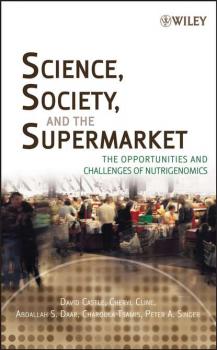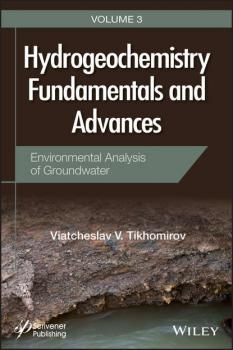ТОП просматриваемых книг сайта:
Техническая литература
Различные книги в жанре Техническая литература, доступные для чтения и скачиванияАннотация
Regulation of Functional Foods and Nutraceuticals: A Global Perspective offers a comprehensive resource for information on regulatory aspects of the growing and economically important functional food industry. Regulatory systems and definitions of key terms-food, supplement, drug, etc-vary from country to country. A thorough understanding of laws and regulation within and among key countries with regard to functional foods, herbal extracts or drugs, and nutritional supplements is critical to the direction of food companies that are developing products for these markets. International experts with legal and/or scientific expertise address relevant topics from quality issues, to organic foods to labeling. Innovative product development within the framework of existing regulations will be addressed in individual chapters. Overview chapters will discuss global principles, inter-country trading issues, and present a comparison of the laws and regulations within different countries graphically. A «must-have» handbook for research professionals, management, and marketing strategists in the worldwide functional foods/nutritional supplements business. Food technicians and engineers responsible for manufacturing quality in this industry should add it to their library to ensure that they have a thorough knowledge of the applicable legal requirements. The book will also serve as an indispensable shelf reference for lawyers in the food industry and government health professionals with regulatory responsibilities.
Аннотация
Sensory discriminative analysis forms a fundamental type of methodology and is used widely in sensory and consumer research. Sensory Discrimination Tests and Measurements: Statistical Principles, Procedures and Tables provides a comprehensive discussion of sensory discriminative analysis from a statistical perspective. A wide variety of test and measurement methods, which were developed during the past decades and scattered in various statistical and non-statistical journals, are included in the book. The book gives a unified picture of the state of the subject and reflects some features of advanced sensory discriminative analysis. Designed to be both a reference manual and a research monograph, practitioners will discover various useful test and measurement procedures. More statistically-oriented readers will find the statistical considerations behind the procedures. Sensory Discrimination Tests and Measurements will be of interest to everyone concerned with testing and measuring sensory difference and consumer preference.
Аннотация
Sensory scientists are often faced with making business decisions based on the results of complex sensory tests involving a multitude of variables. Multivariate and Probabilistic Analyses of Sensory Science Problems explains the multivariate and probabilistic methods available to sensory scientists involved in product development or maintenance. The techniques discussed address sensory problems such as panel performance, product profiling, and exploration of consumer data, including segmentation and identifying drivers of liking. Applied in approach and written for non-statisticians, the text is aimed at sensory scientists who deal mostly with descriptive analysis and consumer studies. Multivariate and Probabilistic Analyses of Sensory Science Problems offers simple, easy-to-understand explanations of difficult statistical concepts and provides an extensive list of case studies with step-by-step instructions for performing analyses and interpreting the results. Coverage includes a refresher on basic multivariate statistical concepts; use of common data sets throughout the text; summary tables presenting the pros and cons of specific methods and the conclusions that may be drawn from using various methods; and sample program codes to perform the analyses and sample outputs. As the latest member of the IFT Press series, Multivariate and Probabilistic Analyses of Sensory Science Problems will be welcomed by sensory scientists in the food industry and other industries using similar testing methodologies, as well as by faculty teaching advanced sensory courses, and professionals conducting and participating in workshops addressing multivariate analysis of sensory and consumer data.
Аннотация
While many food science programs offer courses in the microbiology and processing of fermented foods, no recently published texts exist that fully address the subject. Food fermentation professionals and researchers also have lacked a single book that covers the latest advances in biotechnology, bioprocessing, and microbial genetics, physiology, and taxonomy. In Microbiology and Technology of Fermented Foods, Robert Hutkins has written the first text on food fermentation microbiology in a generation. This authoritative volume also serves as a comprehensive and contemporary reference book. A brief history and evolution of microbiology and fermented foods, an overview of microorganisms involved in food fermentations, and their physiological and metabolic properties provide a foundation for the reader. How microorganisms are used to produce fermented foods and the development of a modern starter culture industry are also described. Successive chapters are devoted to the major fermented foods produced around the world with coverage including microbiological and technological features for manufacture of these foods: • Cultured Dairy Products • Cheese • Meat Fermentation • Fermented Vegetables • Bread Fermentation • Beer Fermentation • Wine Fermentation • Vinegar Fermentation • Fermentation of Foods in the Orient Examples of industrial processes, key historical events, new discoveries in microbiology, anecdotal materials, case studies, and other key information are highlighted throughout the book. Comprehensively written in a style that encourages critical thinking, Microbiology and Technology of Fermented Foods will appeal to anyone dealing in food fermentation – students, professors, researchers, and industry professionals.
Аннотация
The new science of nutrigenomics and its ethical and societal challenges Gene-diet interactions–which underlie relatively benign lactose intolerance to life-threatening conditions such as cardiovascular disease–have long been known. But until now, scientists lacked the tools to fully understand the underlying mechanisms that cause these conditions. In recent years, however, strides in human genomics and the nutritional sciences have allowed for the advancement of a new science–dubbed nutrigenomics. Although this science may lead to personalized nutrition and dietary recommendations that can mitigate, prevent, or cure sickness, current oversight mechanisms and regulations for emerging direct-to-public nutrigenomic tests are still in their infancy. Science, Society, and the Supermarket: The Opportunities and Challenges of Nutrigenomics discusses the many ethical, legal, and social challenges presented by nutrigenomics. Concerning itself with the basic uses of nutrigenomic research as well as its clinical and commercial aspects, this text sheds light on such issues as: * Opportunities and challenges for nutrigenomics * The science of nutrigenomics * The ethics of nutrigenomic tests and information both in a clinical setting and by private third parties * Alternatives for nutrigenomics service delivery * Nutrigenomics and the regulation of health claims for foods and drugs * Equity and access to nutrigenomics in industrialized and developing countries * Intellectual property issues By taking a proactive bioethical stance on the subject, Science, Society, and the Supermarket offers a thorough and timely analysis on both the benefits and risks of nutrigenomics. Along with a thought-provoking examination of the issues, this book provides ethical guidelines and recommendations for further study in policy and regulatory development.
Аннотация
A comprehensive synthesis of the best practices for management in the vital and rapidly growing field of sustainable water systems Handbook of Knowledge Management for Sustainable Water Systems offers an authoritative resource that goes beyond the current literature to provide an interdisciplinary approach to the topic. The text explores the concept of knowledge management as a key asset and a crucial component of organizational strategy as applied to the sustainability of water systems. Using the knowledge management framework, the authors discuss socio-hydrology sustainable water systems that reflect the present political, economic and technological reality. The book draws on contributors from a number of disciplines including: economic development, financial, systems-networks, IT/IS data/analytics, behavioral, social, water systems, governance systems and related ecosystems. This vital resource: Contains a multifaceted approach that draws on a number of disciplines and contains contributions from experts in their various fields Offers a coherent approach that discusses the dynamic concept of sustainability drawing on data from people, systems and processes of diverse water systems Includes a comprehensive review of the topic and offers a platform for dialog between theory and empirical analysis Explores opportunities for multi-constituent synthesis This book is written for regulators, water utility practitioners, researchers and students interested in the fledgling field of knowledge management and sustainable water systems and those who want to improve the effective and efficient management of a complex water system.
Hydrogeochemistry Fundamentals and Advances, Environmental Analysis of Groundwater - Viatcheslav Tikhomirov V.
Аннотация
Water is the Earth’s most precious resource. Until recent years, water was often overlooked as being overly abundant or available, but much has changed all over the world. As climate change, human encroachment on environmental areas, and deforestation become greater dangers, the study of groundwater has become more important than ever and is growing as one of the most important areas of science for the future of life on Earth. This three-volume set is the most comprehensive and up-to-date treatment of hydrogeochemistry that is available. The first volume lays the foundation of the composition, chemistry, and testing of groundwater, while volume two covers practical applications such as mass transfer and transport. Volume three, which completes the set, is an advanced study of the environmental analysis of groundwater and its implications for the future. This third volume focuses more deeply on the analysis of groundwater and the practical applications of these analyses, which are valuable to engineers and scientists in environmental science, groundwater remediation, petroleum engineering, geology, and hydrology. Whether as a textbook or a reference work, this volume is a must-have for any library on hydrogeochemistry.
Аннотация
Forty-two chapters by international experts from a wide range of disciplines make The Wetlands Handbook the essential tool for those seeking comprehensive understanding of the subject. A departure from more traditional treatises, this text examines freshwater wetland ecosystem science from the fundamentals to issues of management and policy. Introductory chapters address the scope and significance of wetlands globally for communities, culture and biodiversity. Subsequent sections deal with processes underpinning wetland functioning, how wetlands work, their uses and values for humans and nature, their sensitivity to external impacts, and how they may be restored. The text is illustrated by numerous examples, emphasising functional and holistic approaches to wetland management, including case studies on the wise use and rehabilitation of wetlands in farmed, urban, industrial and other damaged environments, highlighting the long-term benefits of multiple use. The Wetlands Handbook will provide an invaluable reference for researchers, managers, policy-makers and students of wetland sciences.
Аннотация
Since the 1980s, and especially since the Rio Earth Summit in 1992, there has been a substantial extension in the adoption and use of Environmental Assessment (EA) procedures in developing countries and countries in transition (low and middle income countries). However, few existing texts in environmental assessment or development studies have reflected this trend sufficiently, until this publication. Divided into two main parts: * EA Principles, Processes and Practice. * Country and Institutional Studies of EA Procedures and Practice. This book explains the essentials of environmental impact association in the context of developing countries and assesses its importance to both developed and developing countries.
Аннотация
Wiley's Remediation Technologies Handbook: Major Contaminant Chemicals and Chemical Groups, extracted from the Enviroglobe database, consists of 368 chemicals and chemical groups. This book lists in alphabetical order these chemical and chemical groups along with the numerous technologies, many of which are patented, or trademarked techniques, to remediate them. A short description of each of these technologies is provided along with appropriate references. Wiley's Remediation Technologies Handbook: Major Contaminant Chemicals and Chemical Groups: Covers the most important chemical and chemical groups that are found to pollute the environment, and the ways to remediate them. Gives succinct abstract describing the numerous technologies used to clean-up a wide range of pollutants. Provides the uses and limitations of each technique. Note: CD-ROM/DVD and other supplementary materials are not included as part of eBook file.










